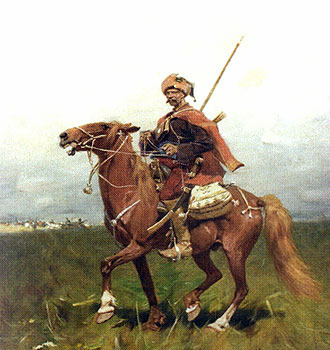A Brief History of the Cossacks
The Cossacks owe their origins to the mixing of Asiatic and Slavic cultures on the Russian steppes that had been a part of Russian life since the first Slavic migrations out of the Carpathian Mountains.
The first group of horsemen to gain the term Cossacks were Tartar (descendents of the Mongol Golden Horde) freebooting outlaws robbing and raiding without Tartar permission. They were called Kazaks by Greek and Turkish traders in the early 14th century, a Turkish word of Arabic origin. Kazak soon found its way into the Tartar, Polish and Russian languages.
By the 15th century bands of Tartar Kazaks, organised on Mongol principles (groups of 10 forming the base unit), were roaming and raiding in the Russian principalities, Lithuania-Poland and even Tartar Khanates. Soon their numbers grew to the point where they were braving direct confrontations with organised forces.
One such raid in 1443 into the Russian principality of Riazan resulted in the granting of winter refuge to the Kazak band, who by the following year were fighting along side their new Russian allies against other Tartar raiders. At about the same time Basil II of Moscow granted refuge to a dissident Tatar Khan and allowed then to settle in the lands between Moscow and Kazan, they too were soon fighting along side their Russian allies as Kasimov Cossacks (named after their leader Khan Kasim).
As the once great Mongol empire shrank and their borders retreated wide tracks of wild steppe land became a frontier land claimed by no state, the ideal home for Tatar Cossacks to roam free. Soon the groups were not just attracting Tartars, but Russians, Poles, Lithuanians and other peoples of the region. Much like western Europeans escaping to the new world in the 18th and 19th centuries, the poor, criminals and dispossessed of 15th and 16th century eastern Europe soon flocked to the open steppe looking for a new life and freedom from life under the Russian princes.
By mid 15th century these two groups were mingling and by the 16th century the integration of the European and Tartar Cossacks was well underway.
On the western steppe the initial wave of European Cossacks were summer migrants, returning to frontier towns in Russian and Lithuania-Poland with the onset of winter.
To control the growing bands of brigand Cossacks Muscovite and Polish authorities try to exercise some form of control over the Cossack bands by enrolling them for military service as border troops, these became “registered” Cossacks and by 1620 the Poles alone had some 6000 in their service.
Not all Cossacks found service in the military; some were simply rounded up and pressed into serfdom (a kind of peasant slavery common in eastern Europe up until the 18th century). In fact as the Russian state became more and more authoritarian in later centuries it would be escaped serfs that would swell the numbers of Cossacks.
Pressure from both states pushed Cossacks further east and south, forcing them to stay on the steppe all year round.
Without the threat of military service and return to serfdom these new “Free” Cossack communities could grow. One major settlement was on the Don River and it inhabitants became known as the Don Cossacks. The other large group was based on the Lower Dnieper River, the got their name form the location of their base Zaporozhsksya Sich (the clearing below the cataracts), so the Lower Dnieper Cossacks became the Zaporozhian Cossacks.
By 1600 further important Cossack hosts (a tribe or band of Cossacks) had come to prominence on the Rivers Yaik (Ural Cossacks) and Terek.
Continue:
https://www.flamesofwar.com/Default.aspx?tabid=112&art_id=696&kb_cat_id=35




